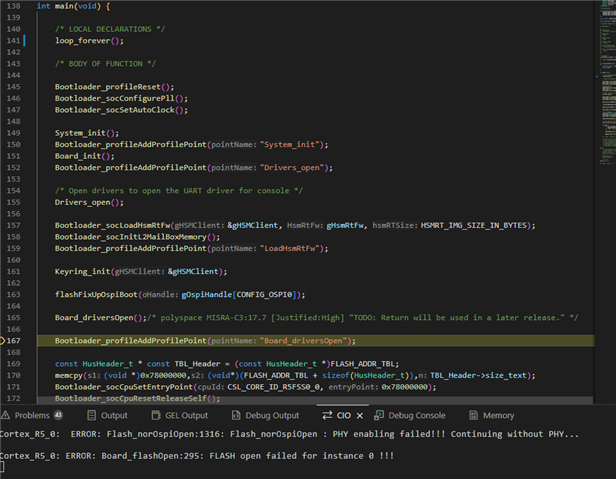Other Parts Discussed in Thread: UNIFLASH, SYSCONFIG
Tool/software:
After downloading and installing the latest SDK, we've already noticed some issues related to the SBL OSPI examples.
1) The sbl_ospi folder is empty. Did this example just go away in favor of some other example? its odd that the folder still exists, but is empty.
2) Not all of the SBL OSPI examples got their OSPI pins assigned. Looking at the sbl_ospi_fastboot/am263px-cc example.syscfg, it is clearly setup to suggestSolution (resolves to "Any" within syscfg) for all the pins on the OSPI.
3) The sbl_ospi_multicore_elf/am263px-cc example.syscfg has ALMOST all the ospi pins assigned. The RESET_OUT0 is still configured to suggestSolution of EPWM11_B. When built, this project (and the previous sbl_ospi from sdk 10_02_00_15, and the sdk 11_00_00_00_19 sbl_ospi_fastbook/am263px-cc) the RESET_OUT0 pin resolves to EPWM11_B (seen in the pinmux.csv as well as the ti_pinmux_config.c).According to the schematic (and verified through code we've developed), this pin on the am263px-cc is actually connected to the USER_LED1, and only the USER_LED1. Within this project is a very specific flashFixUpOspiBoot() function which calls The OSPI_setResetPinStatus() function to set the pin high then low. Although its hard to tell if those reset functions actually get called with our version of the control card (they appear to get skipped).
We continue to have stability issues with the SBL examples, where they will build/run fine for a few hours and then suddenly they will stop correctly booting. There still does not seem to be a truly valid example solution in the latest SDK.




